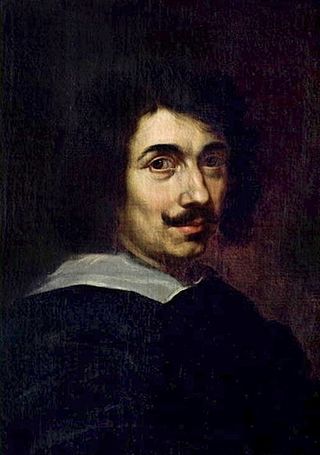
Claude Lorrain was a French painter, draughtsman and etcher of the Baroque era. He spent most of his life in Italy, and is one of the earliest important artists, apart from his contemporaries in Dutch Golden Age painting, to concentrate on landscape painting. His landscapes are usually turned into the more prestigious genre of history paintings by the addition of a few small figures, typically representing a scene from the Bible or classical mythology.
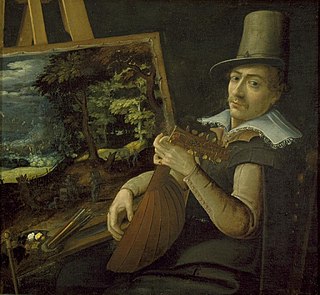
Paul Bril was a Flemish painter and printmaker principally known for his landscapes. He spent most of his active career in Rome. His Italianate landscapes had a major influence on landscape painting in Italy and Northern Europe.

Jean-Baptiste Oudry was a French Rococo painter, engraver, and tapestry designer. He is particularly well known for his naturalistic pictures of animals and his hunt pieces depicting game. His son, Jacques-Charles Oudry, was also a painter.

Johann Rottenhammer, or Hans Rottenhammer, was a German painter. He specialized in highly finished paintings on a small scale.

Marten Ryckaert or Maerten Ryckaert, was a Flemish landscape painter. He was known for his small, usually imaginary landscapes in an Italianate style.
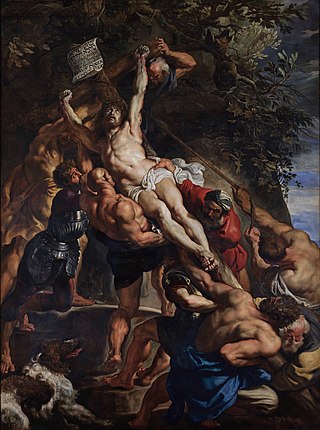
Flemish Baroque painting was a style of painting in the Southern Netherlands during Spanish control in the 16th and 17th centuries. The period roughly begins when the Dutch Republic was split from the Habsburg Spain regions to the south with the Spanish recapturing of Antwerp in 1585 and goes until about 1700, when Spanish Habsburg authority ended with the death of King Charles II. Antwerp, home to the prominent artists Peter Paul Rubens, Anthony van Dyck, and Jacob Jordaens, was the artistic nexus, while other notable cities include Brussels and Ghent.

Jacques Fouquier, Jacques Fouquières or Jacob Focquier was a Flemish landscape painter. After training in Antwerp he worked in various places where he often obtained appointments as a painter to the court including that of the French kings. He earned great success and a very high reputation during his lifetime and was even referred to as the 'Flemish Titian'. Very few of his paintings have been preserved. His work was influential in his time and was widely circulated thanks to reproductions by various contemporary engravers.
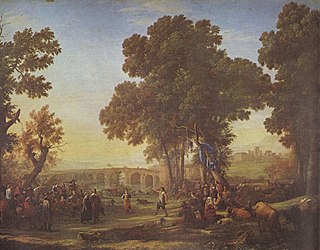
Village Fête is an oil-on-canvas by French artist of the Baroque Claude Lorrain, painted in 1639 and given to Louis XIV in 1693 together with its companion Seaport at Sunset, by landscape architect and gardener André Le Nôtre. It is currently held and exhibited at the Louvre in Paris.

The Hunt is a painting created in 1911 by the French artist Albert Gleizes. The work was exhibited at the 1911 Salon d'Automne ; Jack of Diamonds, Moscow, 1912; the Salon de la Société Normande de Peinture Moderne, Rouen, summer 1912; the Salon de la Section d'Or, Galerie La Boétie, 1912, Le Cubisme, Musée National d'Art Moderne, Paris, 1953, and several major exhibitions during subsequent years.

Gerard Rijsbrack or Gerard Rysbrack (1696–1773) was a Flemish painter of still lifes, game pieces, hunting scenes and mythological scenes. He first worked in England and later in Paris where he received royal commissions. He was the younger brother of the sculptor John Michael Rysbrack, one of the leading sculptors in England around the mid-18th century.

The Pardo Venus is a painting by the Venetian artist Titian, completed in 1551 and now in the Louvre Museum. It is also known as Jupiter and Antiope, since it seems to show the story of Jupiter and Antiope from Book VI of the Metamorphoses. It is Titian's largest mythological painting, and was the first major mythological painting produced by the artist for Philip II of Spain. It was long kept in the Royal Palace of El Pardo near Madrid, hence its usual name; whether Venus is actually represented is uncertain. It later belonged to the English and French royal collections.

Landscape with Sea and Mountain is an oil-on-canvas painting by Flemish painter Joos de Momper. It was painted in the early 1620s, and is now in the Museum of Prado in Madrid.

Mountainous Landscape with a Bridge and Four Horsemen is an oil painting on canvas by the Flemish landscapist Joos de Momper. Its date of execution is unknown. The painting is kept in the Louvre in Paris.

Mountainous Landscape with a Bridge and Four Horsemen is an oil painting on panel by the Flemish painter Joos de Momper. Its date of execution is unknown. The painting was once attributed to Paul Bril. It is part of the permanent collection of the Louvre in Paris.

View of Bracciano is an oil-on-canvas painting by Flemish painter Paul Bril. It was painted in the early 1620s, and is currently housed at the Art Gallery of South Australia in Adelaide. The painting was acquired by the Art Gallery of South Australia in 2007.

Diana and Callisto is an oil-on-canvas painting by Flemish painter Paul Bril. Probably painted in the early 1620s, it was acquired by the National Gallery, London, in 1924.

Mountainous Landscape with Saint Jerome is an oil on copper painting by Flemish painter Paul Bril. It was painted in 1592, and is currently housed at the Mauritshuis in The Hague. The painting was acquired by the Mauritshuis in March 2013. The painting is signed and dated, and represents the earliest dated cabinet painting by Bril. The painting belongs to the period when Bril associated with Jan Brueghel the Elder in Rome, in the last decade of the 16th century. Bril's work from the 1590s has some affinity to the work by Brueghel from the same period, and in fact the painting was originally considered a Brueghel.

Alpine Landscape is an oil-on-canvas painting by Flemish painter Tobias Verhaecht. The painting was completed between 1600 and 1615, and is now in the Museum of Prado in Madrid.

Landscape with Venus and Adonis is an oil-on-canvas painting by Flemish painter Tobias Verhaecht. The work was probably painted in the 1600s, and is now in the Thyssen-Bornemisza Museum in Madrid.
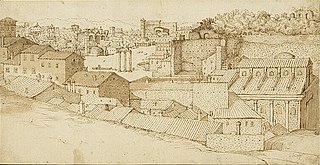
Jacob Franckaert or Jacob Franquart was a Flemish painter and draftsman. After training in Antwerp, he worked in Brussels and later moved to Italy where he worked in Naples and Rome. He is known for his religious subjects, landscapes and architectural scenes.




















